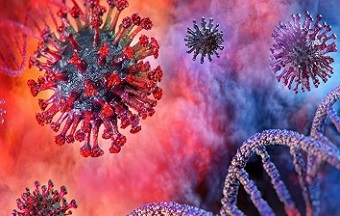Study Reveals That I210T, V213G, S371F, S373P, T478K, F486V, Y505, D796Y Mutations Enhances SARS-CoV-2 Binding With ACE2 And NRP1 Receptors!
TMN Medical News Team Aug 08, 2023 2 years, 3 months, 3 weeks, 3 days, 14 hours, 52 minutes ago
The Y505H spike mutation found in the new SARS-CoV-2 sub-lineages circulating in Pakistan were most concerning with regards to enhanced viral transmission and being more neurovirulent!
COVID-19 News: The ongoing battle against the SARS-CoV-2 virus, responsible for the COVID-19 pandemic, has taken various twists and turns with the emergence of new viral variants. These variants have sparked concerns about their potential to alter transmission dynamics, evade diagnostic methods, undermine therapeutic approaches, and even compromise vaccine efficacy as covered in various
COVID-19 News reports.

Amid this backdrop, a new study conducted at the University of the Punjab in Lahore, Pakistan, delves into the intricate world of viral mutations and their impact on the interaction between the virus and human cellular receptors.
The Unveiling of Mutations
In a quest to unravel the mysteries of the virus-host interaction, the study team embarked on a mission to investigate how newly identified mutations in the SARS-CoV-2 virus affect its ability to bind with key human receptors, namely ACE2 (Angiotensin-Converting Enzyme 2) and NRP1 (Neuropilin-1). Utilizing the power of in-silico analysis, a cutting-edge computational approach, the study aimed to shed light on the potential repercussions of these mutations at a molecular level.
The Method Behind the Analysis
With the genomic sequences of 41 SARS-CoV-2 strains in hand, the researchers employed advanced sequencing techniques, specifically Ion Torrent (Next-Generation Sequencing), to capture the intricate genetic information. These sequences were meticulously deposited into the GISAID database, a valuable resource for tracking viral mutations and their spread. The focal point of the study lay in the spike protein of SARS-CoV-2, a key player in the virus's entry into human cells. This spike protein sequence underwent transformation, transitioning from a mere genetic code to a functional protein sequence with the aid of ExPasy, a bioinformatics tool.
The heart of the investigation revolved around computational simulations that replicated the dynamic dance between the spike protein and human receptors. The researchers harnessed a suite of tools including Molecular Dynamics Docking, Molecular Dynamics Simulation, and MMGBSA (Molecular Mechanics Generalized Born Surface Area) to peer into the subtle shifts and interactions occurring at the atomic level.
Revealing the Insights
The outcomes of this rigorous analysis painted a captivating picture of the effects induced by mutations in the virus. Distinct mutations, including I210T, V213G, S371F, S373P, T478K, F486V, Y505H, and D796Y, exhibited a range of structural impacts while developing enhanced binding with the ACE2 and NRP1 receptors.
These effects encompassed alterations in transmembrane protein structure, the emergence or loss of specific structural elements such as strands and disulfide linkages, and modifications within ordered interfaces. Particularly noteworthy was the trend of decreased stability observed in the spike protein as a result of most mutations. These findings unveiled a complex web of struct
ural consequences and hinted at potential implications for the overall stability and function of the virus's spike protein.
The spotlight shone on the SARS-CoV-2 spike protein, illuminating multiple mutations that orchestrated changes in transmembrane protein structure. These mutations, scattered across different genomic regions such as ORF8, ORF1A, and ORF1AB, triggered a symphony of structural shifts. The orchestra of alterations encompassed modifications in ordered and disordered interfaces, as well as the gain or loss of critical functional sites.
The Rise of Y505H
Of particular interest among the mutations was Y505H, a mutation that emerged as a potential game-changer. This mutation, a novel find not reported in previous studies, seemed to wield the power to enhance the binding affinity between the spike protein and human receptors. This magnetic attraction could potentially lead to heightened infectivity and transmissibility. The findings of the study resonated with earlier research and echoed concerns regarding the potential for Y505H to catalyze a surge in viral transmission.
Pondering the Implications
The narrative surrounding SARS-CoV-2 has been colored by the emergence of new variants, and speculation about their effects on transmission dynamics and pathogenicity has loomed large. The mutations dissected in this study have the potential to reshape the landscape of viral transmissibility, virulence, and even impact the effectiveness of existing therapies and vaccines. Consequently, vigilance and dedicated research efforts are imperative to stay one step ahead of the ever-evolving virus.
Molecular dynamics simulations cast a spotlight on the binding affinity between the spike protein variants and human receptors ACE2 and NRP1. The interactions unveiled that these variants exhibited an amplified affinity for the two receptors. This revelation harmonized with prior studies that had hinted at increased binding affinity of spike protein variants for these receptors. The study introduced a fresh layer of understanding by dissecting the intricate interaction of spike protein variants with ACE2 and NRP1, thanks to a comprehensive in-silico framework.
Molecular dynamics simulations unveiled an intriguing temporal dimension to the interaction between the spike protein variants and ACE2 or NRP1. The mutated spike protein exhibited accelerated stabilization when engaging with ACE2 after 40 nanoseconds, while its interaction with NRP1 achieved stability after a mere 30 nanoseconds, a swifter connection compared to the wild-type spike protein.
These temporal insights hint at the potential for heightened affinity and interaction between the spike protein variants and human receptors, potentially orchestrating a nuanced interplay in the realm of SARS-CoV-2's transmissibility and pathogenicity. However, it is of utmost importance to note that the study's foundation rests on in-silico analyses, underscoring the necessity for subsequent In-vitro and in-vivo experiments to validate and solidify these findings.
The study findings were published in the peer reviewed Journal of Infection and Public Health.
https://www.sciencedirect.com/science/article/pii/S1876034123002460
For the latest
COVID-19 News, keep on logging to Thailand Medical News.
